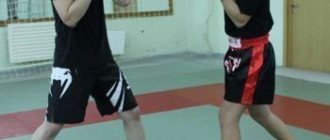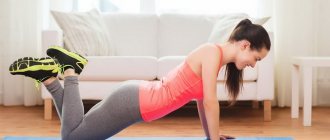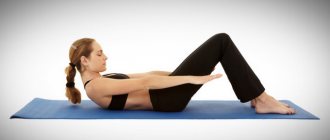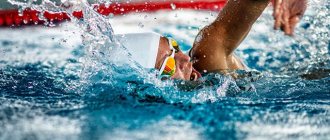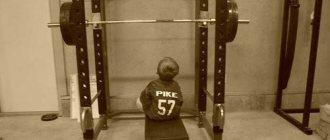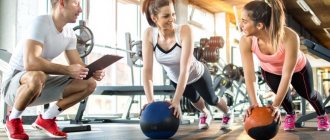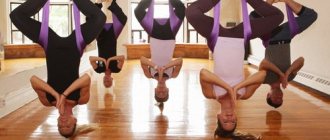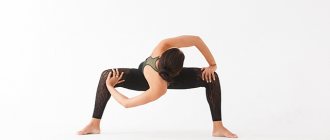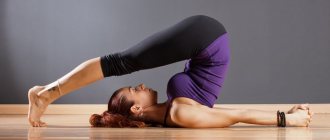Yoga, an ancient practice, has evolved over time but is still relevant today. In the fitness industry in recent years, this is one of the most popular trends.
Power yoga appeared relatively recently, in the late eighties, created by Brian Kest. Many Western trainers worked on its improvement, thanks to which this dynamic practice (a type of Ashtanga yoga) acquired a set of exercises based on synchronized fast movements and controlled breathing. It is characterized by intense training to unify the mind and body, improving speed, endurance and coordination.
For what purpose?
Power yoga is aimed at developing body plasticity and increasing muscle strength. When performing asanas, the emphasis is on breathing. This is a fast pace while maintaining breathing rhythm.
It is accessible to almost everyone. Certain groups of people are especially advised to:
- lovers of strength training, improving their body shape;
- representatives of martial arts who combine their main sport with additional training;
- retired athletes who need to maintain the required level of athletic shape.
Power yoga for beginners involves a series of exercises performed at a set speed. Experts believe that this direction contributes to the formation of a hardy, aesthetic body, develops a person’s internal qualities, and helps to increase physical strength and willpower.
Reference! During classes you need to pay attention to every part of the body. The main load goes to the arms, legs, back and abs. The greatest effect is achieved by accurately performing asanas and holding in one position for about a minute (60-70 seconds).
Adho mukha svanasana
This position is also called “downward-facing dog.” You can perform it at any time, without reference to other asanas. It can replenish lost energy and give lightness to your legs. When performing this exercise, blood rushes to the head and the heartbeat slows down. And of course, the genitourinary system comes into play.
Yoga at home: top 5 best channels on YouTube
Adho mukha svanasana
For men
Basic exercises have a special effect on the stronger sex. In men, a powerful corset of muscles is formed while maintaining their plasticity. Power yoga is used to pump up muscles, develop ease of movement and flexibility of the body. Today, climbers, athletes, tennis players and speed skaters use this direction in their training.
Dynamic power asanas are suitable for men who focus on increasing endurance and developing sculpted muscles. The direction helps to build muscle mass, while maintaining the elasticity and flexibility of the body, which compares favorably with conventional strength training.
Should bodybuilding and yoga be combined?
Now I will list the positive aspects of yoga that can have a positive impact on bodybuilding .
In yoga, various poses are performed daily, which are called ASANA and PRANAYAMA breathing exercises, which have the following effects on the body:
- Increased blood circulation and equalization of hormonal levels;
- Yoga TEACHES TO IMPACT IN ISOLATED MUSCLES, which are very difficult to feel in ordinary life;
- The internal organs are massaged due to rather sophisticated poses;
- Incredible flexibility and stretching of ligaments and tendons;
- Availability;
- Stimulation of the immune system;
- Reducing cortisol (stress hormone) levels and maintaining testosterone levels;
- Enrichment of blood with oxygen;
Now, in order, how will all this help us in building the body?
Regarding blood and hormones
Increased blood circulation will contribute to BETTER DELIVERY OF NUTRIENTS to the muscles, which will help them recover faster after exercise.
The same is true with massage of internal organs . Blood washes them and makes them more elastic, and also stimulates improved performance.
Saturating the blood with oxygen will come in handy ON DRYING, when we need to burn more fat with minimal muscle loss. Oxygen also promotes rejuvenation, as sellers of ozone therapy services say, but this, in my opinion, is still dancing with a tambourine.
But lowering CORTISOL levels and maintaining TESTOSTERONE levels is exactly what any bodybuilder needs! Cortisol (stress hormone) – promotes the breakdown of muscle tissue, which is something you should avoid (by the way, this is why I do not recommend exercising for more than 45-60 minutes in this article). And testosterone is the main ANABOLIC (“anabolism” - growth) hormone, which, on the contrary, promotes the growth of your muscles.
Stimulating the immune system also comes in handy. Especially after 25 years. When we get sick often, it disrupts the micro-, meso- and macrocycles in our training, and also disrupts recovery, so significant progress can be blocked.
Regarding movement mechanics and the central nervous system
First of all, FLEXIBILITY . The way a yogi’s body can bend is simply amazing, comrades. But how does flexibility help a bodybuilder? ELEMENTARY! The ligaments and tendons of flexible people are more elastic, which means the risk of injury is reduced, and the MUSCLE FASCIA (the bags in which our muscle fibers lie) also STRETCH, and the more elastic they are, the easier it is for the muscles to grow.
And in general, spend enough time stretching and warming up. A person who once did the splits, even after many years, will be able to do it again, just by practicing for a couple of weeks. Why is that? Yes, because IT DOESN'T INTERFERE WITH THE BODY! This does not waste extra energy (stretching skill), which means there is no point in wasting energy on eliminating it.
Another important point! Yoga TEACHES TO INFLUENCE MUSCLES IN ISOLATE. Remember how I keep saying that you need to feel your muscles? Well, yoga will teach you this perfectly!
During yoga classes, you will be able to feel those muscles that are difficult to feel individually even in the gym (rear delta, for example). And this will help you COMPETENTLY CONTRACT your muscles during your workouts with iron. Muscular feeling is VERY IMPORTANT so that the load hits the target and is not spread across the helping muscles (synergists).
The accessibility of yoga is also encouraging. By taking yourself a small rug 1.5 x 1.5 meters, you can already start learning this activity.
For women
The body of the fair sex reacts somewhat differently to Power yoga classes. First of all, strength exercises and tempo breathing strengthen the muscles. There is no need to worry about excess muscle mass; girls will not develop it. Asanas create an athletic and feminine body. Breathing technique has a specific effect on a woman’s reproductive system and reduces pain during menstruation.
This type of yoga gets rid of extra pounds and is practiced for weight loss and weight stabilization. It also serves as a source of spiritual strength and improves self-control and self-confidence.
Bodybuilding and yoga. Body adaptation
As we said, bodybuilding and yoga force our bodies to adapt.
TRANSFORMATION OCCURS not only the body, but also the mind. We become more adaptable to our environment, better able to cope with stress, more confident and healthier.
But is it still possible and necessary to combine yoga and bodybuilding?
Is it possible to combine bodybuilding and yoga?
This is the question that worried many people. Well, the topic is really interesting, so I’ll give you some practical recommendations in this regard.
Remember that:
“Loads that are multidirectional in nature give an average, unexpressed result”
This is more about high performance sports.
- If you want to become a professional bodybuilder, then prepare to be less durable and not as flexible as a YOG.
- If you want to achieve liberation (moksha), develop your maximum flexibility and clear your mind, then get ready for the fact that your muscles will not be as juicy and capable of withstanding a very large volume of load as a BODYBUILDER.
Do you get the idea? You need to focus on one thing if you want to achieve PROFESSIONAL, OUTSTANDING RESULTS. But what now, you can’t do yoga and bodybuilding at the same time? Take your time, friends.
I gave above very rare examples. VERY RARE! How many professional bodybuilders do you know on the planet with an IFBB (International Federation of Bodybuilding) professional card? 100-200? And what? This is for 7 billion people, friends. THIS IS VERY LITTLE!
It's the same with yogis. Are there many people on planet Earth who are completely devoted to yoga? FULLY! Those. not just those who stretch out on the rug in their living room, but everything as it should be: temple, purification of consciousness, service to the highest Deity, hours of daily meditation, crazy stretching, etc.? The answer is simple: VERY LITTLE! Maybe several thousand people on the WHOLE PLANET! Do you understand?
Those. the absolute majority who want to combine these types of activities ARE NOT PROFESSIONALS! This means you can find points of contact that will lead to synergy (strengthening both qualities). In my deep conviction, you can achieve quite high results in both areas at the same time. And for the ABSOLUTE MAJORITY, even this will be a lot, believe me.
Benefits and Benefits
Strength exercises create a strong and beautifully built figure. The result is achieved by gradually increasing the approaches, increasing the load, and regularity of exercises.
The advantages of exercise are obvious:
- the training process is carried out without sports equipment;
- there is no need for strict, grueling diets;
- excess weight disappears, the figure acquires graceful and elegant forms, high plasticity;
- formation of the right attitude towards nutritional benefits.
Reference! Asanas can be performed daily. They do not cause overload and overstrain, strengthen the body, improve tone and mood.
What is power yoga
The difference between power yoga and classical yoga is great. While classical yoga is designed to develop flexibility of the body and mind, strength yoga is designed to lose weight and improve the muscle frame. Using the Birch technique, you can make your body more defined and muscular without resorting to strict diets or heavy physical activity.
The exercise sets are designed in such a way that the asanas alternate correctly and help the practitioner lose weight, train endurance and flexibility. The workouts are universal and can be tailored to suit any person. Even those who have never done sports or yoga can try this type of physical activity and benefit from it.
Trainings are organized in such a way as to take into account the age, weight, physical fitness, and experience of the students. Beginners cannot assess the degree of difficulty of certain asanas and their effect on the body. If you approach the training process competently, then the student will gradually develop developed muscle mass. The fat layer, on the contrary, will thin out, and the body will actively extract energy from it for its vital functions. Therefore, a person will not only lose weight, but also preserve the skin, preventing it from becoming flabby, and acquire a muscle corset.
Contraindications
Certain categories of people should not practice power yoga. Exercises are contraindicated for those suffering from mental disorders, neuroinfections and cardiovascular diseases.
There are temporary contraindications. It is not recommended to perform asanas in case of general malaise and physical fatigue, in the period after operations. It is imperative to consult with the trainer and your doctor before starting classes.
- High blood pressure. Caution should be exercised, although blood pressure can be controlled with medications. You should stop training if medications don’t help. It is forbidden to perform any stances; an attack of hypertension can provoke a stroke.
- Injured joints. Athletes with wrist and shoulder injuries should not do handstands. If you have problems with your knees, the lotus pose is contraindicated. Excessive loads injure joints; they must be protected from overexertion.
- Advanced age. Despite the fact that power yoga exercises can be performed at any age, there are certain contraindications and recommendations for older people. When exercising, you need to be careful and pay more attention to your health, balance the load and level of training. Experts advise exercising under the guidance of a professional trainer to avoid injuries and health problems.
Muscle development in hatha yoga
Muscle work in yoga differs from other types of training. Let's figure out why and what is the benefit of it.
White fiber
Each muscle is made up of red and white fibers.
White fibers are responsible for strength and speed. The higher the load power, the greater the percentage of white fibers included in the work. At a load of up to 40%, predominantly red fibers work; from 40 to 60%, both red and white fibers work. And about 60% are only white. White fibers also work during fast movements - jumping, hitting.
In everyday life and for maintaining posture, white fiber does little work.
White fiber only works on glucose; it does not work on other resources. Therefore, it is distinguished by a large number of enzymes for the rapid oxidation of glucose and an increased intracellular delivery system - the sarcoplasmic reticulum. White fiber does not require oxygen and breaks down glucose quickly, but not inefficiently. In a short time, a lot of energy is obtained, but quite quickly the muscle runs out of glucose (in the form of starch glycogen). And then the muscle needs to rest for a long time. And complete restoration of glucose reserves in the muscle takes at least a day. During the glycolytic work of white fiber, a large number of metabolic products are produced - hydrogen ions and lactic acid, which enter the blood.
When white fiber is trained, it increases significantly in size due to an increase in the number of active fibers, sarcoplasmic reticulum and glycogen stores.
Static load does not train the white fiber very effectively. However, some results can be achieved with the help of yoga. For this purpose, either multiple “entries” into a form that is difficult for a person are suitable. For example, the Tabata protocol in statics consists of repeated fixations of a difficult pose for 20 times, with a break of 10 seconds between approaches.
Red fiber
Red muscle fiber is responsible for muscle endurance under moderate loads. It is used to maintain posture, endurance when carrying heavy loads, not running fast, etc.
Red fiber is this color because it is rich in mitochondria. It breaks down substrates in mitochondria using oxygen. It is the work with red fiber that can be called “aerobic.” When fitness training with a large number of jumps is called aerobic exercise, this is incorrect, because... White fiber works a lot there and consumes little oxygen.
Red fiber can break down both glucose and fatty acids. Therefore, the more active red muscle fibers a person has, the more fat is utilized during the day, which is beneficial for metabolism, health and longevity.
Substrates break down slowly, which is why red fiber is also called “slow” fiber. But the splitting is very effective. Thus, glucose is completely decomposed into water and carbon dioxide.
This reduces acidification in the body. What is important for people with weakened cardiovascular function, for example in retirement. Hiking in the mountains will not cause such intense work of the heart as in a person who has trained predominantly white fibers in his life.
Since the red fiber is not suitable for rapid loading, and it is very difficult to tire it with cyclic loading, special training methods are needed.
Red fiber is sensitive not so much to a lack of energy resources as to a lack of oxygen. Therefore, it trains by working against the background of limiting the supply of oxygen - i.e., the supply of fresh blood.
For this, static or “isotonic” exercise systems are used. Isotonic exercises are when a person moves slowly with a load on a specific muscle, and his work force is approximately the same. During such work, the pressure in the muscle is constantly increased, and the blood flow is weak.
But still, the most effective method of training the red fiber will be a static (“isometric”) load - when the working muscle does not move at all. Then fresh blood and oxygen do not enter the muscle at all; it has to use the internal oxygen resource. When training red fibers in a muscle, their active number, the number of mitochondria to provide energy, and the capillary network serving the muscle increase. Increasing the capillary network, important for the cardiovascular system, is one of the factors in the prevention of high blood pressure.
When training red fiber, muscles increase in volume much less than when training white fiber. What can be especially significant for women.
Modes used in the practice of hatha yoga
Less effective
1. Isotonic regime
The term “isotonic” means non-stop muscle work with a constant amount of effort. The muscle moves “around” a certain difficult position, without reaching positions of significant reduction in load. For example - in a wide stance, you slowly squat down and rise up, but do not sit too low or rise so high that it becomes easy for you.
Isotonia can be performed until complete fatigue for 1.5-3.5 minutes, or according to the Seluyanov system: 1 set 30-35s, break 10-15s, so 3-4 sets, break 5 minutes. There are 3-4 such sets per workout.
2. Statics to the limit
Statics (isometry) blocks the flow of oxygen into the muscle even more effectively than isotonic work.
Typically: 1.5-3.5 min.
As the rack is fixed in the fibers that turned on first, the process of depletion of energy resources occurs, a stimulus for development is triggered (encoding in RNA, etc.) and destruction processes occur. Gradually other fibers are connected. If you keep a muscle in this state for too long, in the fibers that were depleted first, the destruction process becomes more and more intensified, which will lead to poor recovery and a decrease in the effectiveness of the practice.
This mode is recommended for occasional use to assess the maximum endurance capabilities of red fiber, but not as a permanent training regimen.
3. Short statics with numerous repetitions (for hatha yoga this mode can be called dynamic).
10-20 repetitions are performed with fixation in the working position for 3-6 seconds, the rest phase tends to a maximum decrease (1-4 seconds).
Work on mixed fibers.
4. Combination of “dynamics” and statics.
First, 8-15 repetitions, as in the previous version, then pure static 20-60s.
More emphasis on red than in the previous mode.
More efficient
5. Static at 70s - now we have the main mode
T.N. "Agapkin protocol". Static exercises of 70 seconds for selected muscle groups are performed 3-10 times per workout with a break between approaches of 5 minutes (at this time other muscle groups are done).
70s, according to the physiology of muscle training, is enough to trigger improvement processes in the muscle, while we do not have time to lead it to excessive exhaustion. And repetition several times during training causes a more intense “recoding” of RNA than performing the pose once.
The depletion of a number of fibers is indicated by a feeling of heaviness and “difficulty” in the muscle, which lasts for 20-30 seconds. If this heaviness does not occur until 70s, the position is considered easy and should become more difficult.
6. Cyclic shift of emphasis based on statics
Variation of the previous mode.
In a static position, when working on a long muscle group, the emphasis of work shifts from one part of the muscles to others. For example, a position lying on your stomach, feet on the floor, maximum elevation of the body and arms, alternating with a lower position of the body and arms, but with legs raised (“swing”). Fixation time - 70 s, or until complete fatigue.
Recommended after mastering pure statics in the previous mode.
7. Statics with pauses - mode for an advanced group
Approximately 20 seconds of fixation, 10 rest pause, 8 approaches (the same exercise 8 times in a row). After some time, the set can be repeated.
The blood in the muscle is partially renewed, and more fibers are recruited. Because when fixing for 20 seconds, you can hold more complex positions, and the white fiber is also trained.
Develops more strength than the previous mode. Since it is more difficult, it is recommended for experienced practitioners; in addition, it is advisable for beginners to focus on endurance.
Pressure at static load
Static work is complicated by the fact that during it some small vessels are compressed (in working muscle groups), and the peripheral vascular resistance increases - i.e. lower pressure. The upper one also grows compensatory. Actually, this process also occurs during dynamic work, but for a short time. So the whole question is the duration of the increase in pressure.
With a well-constructed training in a study of people with a normal state of the cardiovascular system and no hypertension, immediately after power static poses and after the end of the training, no increase in initial pressure was recorded. Those. For a healthy person, under normal warm-up conditions, with breaks between static strength stretching exercises and dynamic movements, static strength poses do not pose a threat to a prolonged increase in pressure.
However, it is important that in complex static exercises with tension in a large number of muscle groups, the pressure can reach 165/113, and maybe even higher. Therefore, strength exercises in a static mode with prolonged hold are not recommended for people prone to significant increases in blood pressure, with a number of problems of the cardiovascular system, as well as for beginners.
These groups of students (as well as the “conditionally healthy” ones, but to a lesser extent) are recommended to:
- Avoid prolonged static conditions.
- Avoid prolonged static exercises with simultaneous tension of a large number of muscle groups. For example, various options for stops. Replace them with exercises in the mode of reciprocating movements
- Get enough rest between exercises
- It is mandatory to master good diaphragmatic breathing using the “ujjayi” method, and constantly use it in training to reduce abdominal and thoracic pressure during inspiration, which incl. improves blood flow to the heart.
- All people who are prone to high blood pressure or have heart problems should have their blood pressure regularly measured during training. And also for beginners - selectively.
Recommendations for organizing strength training in yoga
Before a muscular load, it is necessary to carry out an activating warm-up, and at the end of the session, conscious relaxation of the muscles and the whole body.
To restore blood circulation in the muscle and the body as a whole, it is advisable to stretch it after work. If several approaches are performed per muscle, stretching the muscle is required after the last approach.
Lifestyle and self-control
For information on nutrition during training, see here.
Before starting training with a pronounced static strength component, it is recommended to “introduce” diaphragmatic breathing and develop the breathing apparatus.
After training, the muscles may “feel” the next day or every other day; for beginners, they may ache, but only a little. A feeling of general fatigue the next day, or several days in a row, indicates that the body is not ready for training of such intensity. Even if the muscles can withstand it, other systems of the body may not cope. In this case, you need to reduce the intensity of your training and/or increase nutrition and rest.
Blood pressure and pulse should be measured regularly. In particular, the pulse in the morning immediately after waking up in bed. If regularly in the morning after training your pulse is higher than usual by more than 5-7 points. Reducing the load, changing the training regimen, and ultrasound of the heart may be recommended. In any case, it is worth informing the teacher.
The restoration and development of muscle cells lasts more than 48 hours, so it is recommended to train no more than 2 times a week.
Each muscle group can be skipped in 20-25% of workouts. Thus, the workouts will differ slightly from each other - by about 25%.
With this training regimen and adequate nutrition and rest, it usually takes 1.5-2 years for a completely untrained person to develop very good muscular endurance.
Articles and books on the topic:
Training pressure studies
Different types of activities and their combination
Report by S. Agapkin on interval hatha yoga
Description of static strength exercises - on the website in the Hatha Yoga section: Practice
For books on the topic , see the page: Exercise Physiology
Next article in the section:
Interval training in yoga
Basic complex for beginners
Basic asanas, like no other, are suitable for beginners to practice power yoga. They will help you master the correct breathing and relaxation techniques and serve as the foundation for increasing muscle strength.
Legendary meditation course without payment We recommend! The most popular meditation course for beginners in Russian. More than 100 thousand people have already learned to meditate. Try it yourself. Read more.
Power yoga includes approximately 300 basic poses. Experienced trainers recommend that beginners use only a few asanas for each workout. This will allow you to create a rich and effective training program.
Achieving success in yoga is impossible without taking into account the capabilities of your body. For this reason, if you feel unwell or dizzy, stop exercising and modify the exercise.
A complex of several asanas (suitable for men and women):
- Rudrasana (sumo pose) . Among power asanas, one of the most powerful. Exercise develops strength and endurance. It is suitable for training the lower back and back, hips, knees and ankles, and abs.
- “Six points” or plank (Kumbhakasana). The asana strengthens the muscles of the body and develops the ability to maintain balance.
- "Tree" (Vrikshasana). An effective exercise for developing flexibility. A novice yogi, having learned to perform the asana, can balance on one leg and control his own breathing.
- Warrior asana (Virabhadrasana). Increases certain qualities of strength and endurance required for yoga practice. The effect is achieved by stretching and strengthening the gluteal and thigh muscles.
- "Boat" (Navasana). Strengthens the abdominal and back muscles, as well as the arms and shoulder girdle.
- Shalabhasana (locust or grasshopper pose). It is used to tone the lower body and increase physical endurance.
Balasana (Child's Pose)
An ideal asana for relaxation. When the whole body has worked well, the time to rest comes in child’s pose. Being in this position, blood does not rush to the head, but is redistributed in favor of the abdominal and pelvic organs.
Popular articles now
Dan Balan does not lose hope: Tina Karol told how her only son feels about the appearance of his sister
Only Balan should have seen this: Tina Karol’s bed photo blew up the Network
Hot on the heels of Tarabarova: Alyosha, who recently gave birth, radically changed her image (photo)
They cut their hair and got the most fashionable haircut of 2020: Zelenskaya, Rotaru, Meikher and other celebrities with a stylish bob (photo)
show more
Child's Pose
A set of five asana exercises is simple and accessible. You can do it in the morning before starting your workday to get a boost of energy or in the evening when your body is tired and needs attention and relaxation. Each pose involves not only the genitourinary system, but also other organs.
Read more useful materials on Clutch.
Watch the video and do exercises to improve blood supply to the pelvis:
For advanced
These several asanas are recommended for experienced practitioners to create a set of exercises:
- "Triangle" (trikonasana). The exercise serves to stretch and strengthen the leg muscles.
- Bhujangasana. Perfectly relieves fatigue, strengthens the spine and buttock muscles.
- Ardha Matsyendrasana. Used to stretch the abdominal muscles, develop the neck muscles and shoulder joints.
- Chaturanga Dandasana. It is performed to strengthen the shoulder girdle and abs, arms and back muscles.
Important! While performing a set of power yoga asanas, you need to maintain a given breathing rate. After completing the exercises, it is recommended to drink water and lie down for general relaxation of the body. Typically, Shavasana (corpse pose) is used for this.
Exercises and complexes
There are several main stages corresponding to certain physical skills of people. It is impossible at the initial stage to immediately begin power yoga, excluding the initial skills of power hatha yoga.
Power yoga for beginners includes:
- They begin to practice by performing the task of rudrasana or power asanas of a sumo wrestler. To do this, place your feet approximately 75 cm wide, with your heels pointing towards each other. Join both hands in the chest area - this pose is called namaste or greeting (palms should rest tightly against each other). Gradually the legs bend and the body goes down. Pay special attention to the position of the hips: they are turned outward. By performing this technique, the calf and thigh muscles are strengthened.
- The next task is to perform virabhadrasana or warrior power asanas. When performing them, you need to lunge forward. The leg that is in front should be bent 90°. Keep the other leg straight, its heel pressed firmly to the floor. Your arms must be bent and your elbows point back. The legs change alternately; it is important to lunge first with one leg, then with the other leg. Strengthens: back, calf and thigh muscles.
- This is followed by Ashtanga Namaskar Asana or Six Points Pose - for this you need to take a lying position on your stomach. Raise your pelvis above the horizontal surface, while resting on your knees. Bend your arms, palms should be placed strictly under your shoulders. Tear off the body by at least 6 cm. Thanks to the exercise, a person’s triceps are trained.
- Vasishthasana, an exercise known as sage power asanas, is performed in an interesting way. Lunge forward with your left leg. The right hand is placed perpendicular to the flat floor. The body itself needs to be turned to the left, the left foot turns to the left, and the right foot is placed on the floor on the outer edge. In order not to lose balance, you need to reach up with your left hand, while tightening your abdominal muscles. This exercise is done on both sides. At the same time, the abdominal muscles and forearms are trained.
- The well-known plank is done as follows - to perform the exercise you need to lie on your stomach, bend your elbows. Raise your body, pelvis, legs above the floor. Elbows and toes will be the fulcrum of the body. The stomach is pulled in, the buttocks are as tense as possible. The muscles of the arms and abdominals are strengthened.
- Then you need to perform the navasana exercise or boat power asanas. The initial pose of this technique: lie on your back, raise your straight legs and body no less than 10 cm. Press your lower back tightly to the floor. The hands of a person doing power yoga reach for his feet. At the same time, the abdominal press is intensively trained.
- The last one is the task of shalabhasana, which is also called grasshopper power asanas. This technique is very similar to boat pose. To perform it, you need to lie on your stomach and lift your legs and body off the floor. The arms are extended up and back, the legs should be held together.
It is very important to maintain a breathing pace throughout the entire gymnastic complex. After all the exercises are done, it is recommended to drink water and lie down, taking a position that will contribute to the general relaxation of the body. This body position is called savasana or corpse pose.
